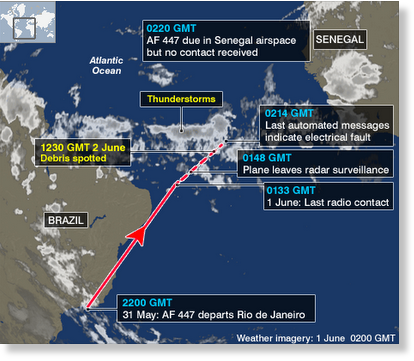Could a meteor have brought down Air France 447? Today we are starting to see reports that there actually may have been a meteor:
However, both pilots of an Air Comet flight from Lima to Lisbon sent a written report on the bright flash they said they saw to Air France, Airbus and the Spanish civil aviation authority, the airline told CNN.Obviously for any given flight the chances are very, very small that a meteor will bring down an airliner, but as Hailey and Helfand pointed out in a letter to the NYT in 1996, the correct question to ask is this: "What is the probability that, for all flights in history, one or more could have been downed by a meteor?" They concluded that there was a 1-in-10 chance that this could happen...let's use their logic, brought up to date somewhat, for 2009, for Flight 447.
"Suddenly, we saw in the distance a strong and intense flash of white light, which followed a descending and vertical trajectory and which broke up in six seconds," the captain wrote.
Comment: And judging from the recent increased activity, the chances are probably even higher than that.
Helfand, an astronomer, is presumably the one who estimated that "approximately 3,000 meteors a day with the requisite mass strike Earth". This is a difficult number to get. How much mass? How fast does it need to be moving? But let's assume that this number is correct; it translates to 125 meteors per hour.
Next we need to know the total number of flight hours at altitude for all commercial planes. In 2000 there were about 18 million flights per year. Clearly in the past 20 years (which we'll take as our reference, since it spans 1989-2009, with both flights 800 and 447) it was not always so...but let's take a guess that the 18 million figure is roughly correct for that 20 year period. That would yield 360 million commercial airline flights from 1989-2000. Hailey and Helfand assumed that each flight was two hours in duration. Again, a tough number to find on line, so we'll take it at face value, giving us 720 million flight hours in our reference period.
They also claim that if there were 3500 planes in the air at any time, this would correspond to covering two-billionths of Earth's surface. Now the earth's surface area is 5×1014 m2. Using my trusty HP-15c, I get that this would imply an average target area for a commercial airliner of 291 m2, which is reasonable. Each plane, that is, covers 5.7×10-13 of Earth's surface. If a meteor hits the earth it has that probability of hitting a given plane on average.
So, in our reference 20-year period we have 720 million hours of flight time, times 125 meteors per hour, times 5.7×10-13 = 0.051, which we can take as the average number of airliners struck by meteors in the period 1989-2009. That's a one-in-twenty chance of some plane going down for this reason in that 20 year period. Extrapolating to all flights ever would require a better estimate of total flight hours, but it's not twenty times the number in the past 20 years, for sure - that is, it's not yet close to one.
Obviously there are a lot of uncertainties in this estimate; perhaps a factor of two from the number of meteors of sufficient mass per day, the average flight duration and number of flights?
Anyway the meteor idea is not crazy, though not likely. The weather seems more likely to be at the root of the tragedy...but we may never know. One thing, though, is clear: if we keep flying big planes at high altitude, eventually one will get hit by a meteor.




Comment: Actually, SOTT called this one when it happened! The reader is invited to take a look at What are they hiding? Flight 447 and Tunguska Type Events, that clearly demonstrates the possibility of Flight 447 being hit by a meteorite or a shockwave from an exploding comet fragment.